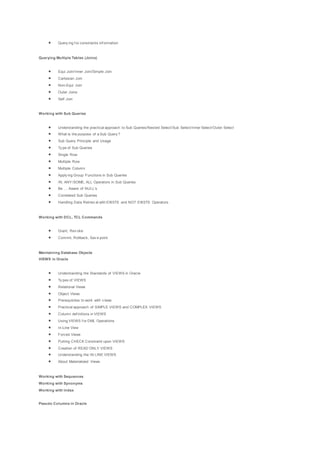Oracle Course content
- 1. ORACLECOURSECONTENT Sub Language Commands: ï· Data Def inition Language (DDL) ï· Data Retriev al Language (DRL) ï· Data Manipulation Language (DML) ï· Transaction Control Language (TCL) ï· Database Security and Priv ileges (DCL) Introduction to SQL Database Object ï· Oracle Pre Def ined Data ty pes ï· DDL Commands ï· Create, Alter (add, modif y , rename, drop)Columns, Rename, truncate, drop ï· DML-Insert, update, delete ï· DQL-SELECT Statements using WHERE clause ï· Comparison and Conditional Operators ï· Arithmetic and Logical Operators ï· Set Operators (UNION, UNION ALL, INTERSECT, MINUS) ï· Special Operators â IN (NOT IN), BETWEEN (NOT BETWEEN), LIKE (NOTLIKE), IS NULL (IS NOT NULL) ï· Working with DML, DRL Commands ï· Operators Support Built in Functions ï· Arithmetic Functions, Character Functions, Date Functions, Conv ersion Functions ï· Aggregate Functions, OLAP Functions & General Functions Grouping the Result of a Query ï· Using Group by and Hav ing Clause of DRL Statement ï· Using Order by clause Working with Integrity Constraints ï· Importance of Data Integrity ï· Support of Integrity Constraints f or Relating Table in RDBMS ï· NOT NULL constraint ï· UNIQUE constraint ï· PRIMARY KEY constraint ï· FOREIGN KEY constraint ï· CHECK constraint ï· Working with dif f erent ty pes of integrity Constraints REF constraint ï· Understanding ON DELETE clause in ref erential integrity constraint ï· Working with composite constraint ï· Apply ing DEFAULT option to columns ï· Working with multiple constraints upon a column ï· Adding constraints to a table ï· Dropping of constraints ï· Enabling / Disable constraints
- 2. ï· Query ing f or constraints inf ormation Querying Multiple Tables (Joins) ï· Equi Join/Inner Join/Simple Join ï· Cartesian Join ï· Non-Equi Join ï· Outer Joins ï· Self Join Working with Sub Queries ï· Understanding the practical approach to Sub Queries/Nested Select/Sub Select/Inner Select/Outer Select ï· What is the purpose of a Sub Query ? ï· Sub Query Principle and Usage ï· Ty pe of Sub Queries ï· Single Row ï· Multiple Row ï· Multiple Column ï· Apply ing Group Functions in Sub Queries ï· IN, ANY/SOME, ALL Operators in Sub Queries ï· Be âĶ Aware of NULLâs ï· Correlated Sub Queries ï· Handling Data Retriev al with EXISTS and NOT EXISTS Operators Working with DCL, TCL Commands ï· Grant, Rev oke ï· Commit, Rollback, Sav e point Maintaining Database Objects VIEWS in Oracle ï· Understanding the Standards of VIEWS in Oracle ï· Ty pes of VIEWS ï· Relational Views ï· Object Views ï· Prerequisites to work with v iews ï· Practical approach of SIMPLE VIEWS and COMPLEX VIEWS ï· Column def initions in VIEWS ï· Using VIEWS f or DML Operations ï· In-Line View ï· Forced Views ï· Putting CHECK Constraint upon VIEWS ï· Creation of READ ONLY VIEWS ï· Understanding the IN LINE VIEWS ï· About Materialized Views Working with Sequences Working with Synonyms Working with Index Pseudo Columns in Oracle
- 3. ï· Understanding Pseudo Columns in Oracle ï· Ty pes of Pseudo Columns in Oracle ï· CURRVAL and NEXTVAL ï· LEVEL ï· ROWID ï· ROWNUM Data Partitions & Parallel Process ï· Ty pes of Partitions ï· Range Partitions ï· Hash Partitions ï· List Partition ï· Composite Partition ï· Parallel Query Process PL-SQL (Procedure Language â SQL) ï· Introduction to Programming Languages ï· Introduction to PL/SQL ï· The Adv antages of PL/SQL ï· PL/SQL Architecture ï· PL/SQL Data ty pes ï· Variable and Constants ï· Using Built_in Functions ï· Conditional and Unconditional Statements ï· Simple if , if âĶ else, nested if ..else, if..else Ladder ï· Selection Case, Simple Case, GOTO Label and EXIT ï· Iterations in PL/SQL ï· Simple LOOP,WHILE LOOP,FOR LOOP and NESTED LOOPS ï· SQL within PL/SQL ï· Composite Data ty pes (Complete) ï· Cursor Management in PL/SQL ï· Implicit Cursors ï· Explicit Cursors ï· Cursor Attributes ï· Cursor with Parameters ï· Cursors with LOOPs Nested Cursors ï· Cursors with Sub Queries ï· Ref . Cursors ï· Record and PL/SQL Table Ty pes Advanced PL/SQL ï· Procedures in PL/SQL ï· STORED PROCEDURES ï· PROCEDURE with Parameters (IN,OUT and IN OUT) ï· POSITIONAL Notation and NAMED Notation ï· Procedure with Cursors ï· Dropping a Procedure ï· Functions in PL/SQL ï· Dif f erence between Procedures and Functions ï· User Def ined Functions ï· Using stored f unction in SQL statements
- 4. ï· Packages in PL/SQL ï· Creating PACKAGE Specif ication and PACKAGE Body ï· Priv ate and Public Objects in PACKAGE EXCEPTIONS in PL/SQL ï· Types of exceptions ï· User Def ined Exceptions ï· Pre Def ined Exceptions ï· RAISE_APPLICATION_ERROR ï· PRAGMA_AUTONOMOUS_TRANSACTION ï· SQL Error Code Values Database Triggers in PL/SQL ï· Ty pes of Triggers ï· Row Lev el Triggers ï· Statement Lev el Triggers ï· DDL Triggers Advanced Features ï· 9i Joins ï· New Date f unction ï· Rename column ï· Inner Join/Natural Join ï· Lef t Outer Join/Right Outer Join ï· Full Outer Join ï· Multiple Inserts ï· Insert All Command ï· Merge statement ï· NVL2(), NULLIF(), COALESCE() ï· CASE expression of Select Command ï· New Function EXTRACT() ï· About Flash Back Queries ï· New data ty pes, Flash back Command ï· Purge Command, Recy clebin




